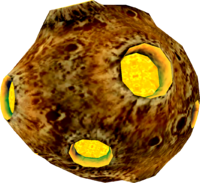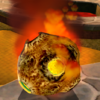Meteor
- This article is about meteors that fall to the ground and act as obstacles. For the larger space rocks that can be ground-pounded in Super Mario Galaxy 2, see Meteorite.
| Meteor | |||
|---|---|---|---|
 Model from Super Mario Galaxy | |||
| First appearance | Super Mario Bros. (1993) | ||
| Latest appearance | Super Mario 3D All-Stars (2020) | ||
| |||
Meteors appear in the Super Mario franchise as hazardous objects that fall from the sky.
History
Super Mario Bros. film
In the 1993 Super Mario Bros. film, it is the meteor that caused the extinction of the dinosaurs that separates Earth into two parallel dimensions; Earth and Dinohattan. While Dinosaurs become extinct on Earth, they prosper and evolve into intelligent beings in the Dinohattan dimension. Unfortunately, said dimension has poor resources and is compromised of almost entirely a barren, desolate desert. President Koopa gains control of the dimension through a military coup, with the intent of merging the two worlds. To do this, it is necessary to use a shard from the meteor to combine the worlds. Said piece of meteor plays a pivotal, key role in the movie.
Donkey Kong Jungle Beat
In Donkey Kong Jungle Beat, meteors appear in two sizes and are surrounded by blue fire. Large ones are used as projectiles by the Roc bosses, while small ones appear in Banshee Swamp, where they follow preset paths through the air, and Asteroid Belt, where they bounce around inside the first asteroid.
Super Mario series
Super Mario Galaxy

Meteors in Super Mario Galaxy crash into some planets in various galaxies periodically. If hit by one, Mario (or Luigi) will take damage. They first appear being shot from cannons by airships in the opening, and appear as obstacles shortly after in the Gateway Galaxy. When Mario traverses the large staircase at the end of Bowser's Star Reactor, Bowser launches meteors from his mouth to destroy the platforms Mario walks on. In Bowser Jr.'s Lava Reactor, they fall from the sky during the final part of the battle with King Kaliente. Meteors prominently appear in the Melty Molten Galaxy in the mission Through the Meteor Storm, where they rain down during the entire mission. The meteors will not spawn if the player is looking directly at their spawn point.
Super Mario Galaxy 2
Meteors, also known as lava spheres,[1]) prominently appear in the Shiverburn Galaxy, where they create temporary pools of lava when they collide with ice. Similar objects that create ice platforms when they fall in lava also appear in the Shiverburn Galaxy.
Meteors also make an appearance in Hightail Falls Speed Run, acting as an obstacle for Dash Yoshi while he runs across walls.
New Super Mario Bros. U
Similar objects known as Bowser's Flames[2] appear in New Super Mario Bros. U; they replace the volcanic debris of previous titles and have the same function, but they shower down more constantly rather than at designated intervals. They appear in the Peach's Castle levels Meteor Moat and Firefall Cliffs. In the former level, they tend to trail behind the player and catch up if they remain in the same spot for too long, and in the latter level, their movement is fixed due to the auto-scrolling element. In New Super Luigi U, they appear in the replacement levels Magma Moat and Firefall Rising. They can be extinguished with an Ice Ball using Ice Mario, but the bigger they are, the more Ice Balls are required to fully extinguish them. In addition, Bowser's fireballs take on the same appearance and can also rain directly downwards. Bowser also shoots down flames in Super Mario Maker and its remake in the New Super Mario Bros. U theme in similar patterns when he is riding a Lakitu's Cloud.
Mario Party: Island Tour
In Mario Party: Island Tour, meteors are found in the minigame Meteor Melee, in which they fall from the sky and deduct points upon collision.
Names in other languages
Meteor
| Language | Name | Meaning | Notes |
|---|---|---|---|
| Japanese | メテオストライク[3] Meteo Sutoraiku |
Meteor Strike |
Bowser's Flame
| Language | Name | Meaning | Notes |
|---|---|---|---|
| Japanese | 火炎弾[4] Kaendan |
Fireball | |
| French | Flamme de Bowser[6] | Bowser's Flame | |
| Italian | Fiamme di Bowser[5] | Bowser's Flame | |
| Korean | 불덩이[?] Buldeongi |
Fireball |
References
- ^ Browne, Catherine (May 23, 2010). Super Mario Galaxy 2: PRIMA Official Game Guide. Roseville: Random House Inc. ISBN 978-0-30746-907-6. Page 189.
- ^ Stratton, Steve (November 18, 2012). New Super Mario Bros. U PRIMA Official Game Guide. Prima Games (American English). ISBN 978-0-307-89690-2. Page 14, 190, and 196.
- ^ October 19, 2015. Super Mario Bros. Hyakka: Nintendo Kōshiki Guidebook, New Super Mario Bros. U section. Shogakukan (Japanese). ISBN 978-4-09-106569-8. Page 137 and 171.
- ^ October 19, 2015. Super Mario Bros. Hyakka: Nintendo Kōshiki Guidebook, New Super Mario Bros. U section. Shogakukan (Japanese). ISBN 978-4-09-106569-8. Page 215.
- ^ November 15, 2018. Super Mario Bros. Enciclopedia. Magazzini Salani (Italian). ISBN 889367436X. Page 215.
- ^ Chaîne New Super Mario Bros. U (January 29, 2013). New Super Mario Bros. U - Château de Peach-4 - Les flammes de Bowser (Wii U). YouTube (French). Retrieved June 28, 2024.
